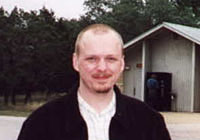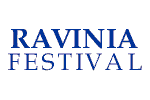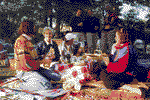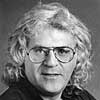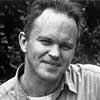Friday, June 11, 1999
Ritz Carlton Hotel Café (Chicago IL)
Zarin Mehta – Executive Director and Chief Operating Officer of the Ravinia Festival
Frank J. Oteri – Editor, NewMusicBox
Interview transcribed by Karyn Joaquino
1. Ravinia’s Beginnings And Now
FRANK J. OTERI: Well, Zarin, I want to thank you for meeting with me on this very hot Chicago day.
ZARIN MEHTA: It’s sunny, though.
FRANK J. OTERI: It is sunny. It’s very nice. Actually, meeting you here on the other side of town was a good excuse for me to get a walk outside of the hotel and to see a little bit of this wonderful city. Hot as it may be, it was great to walk by all of the fantastic architecture of this town. And as long as we’re talking about the architecture of the city of Chicago, I really believe that Ravinia is part of the architecture and the infrastructure of Chicago and has been for over 60 years. So much so that people outside of Chicago are amazed to find out when they visit Ravinia, there’s actually a train that runs—part of the Chicago Transit Authority—that takes you directly inside the festival, and it’s a special train that runs during festival season, and unlike other transit systems in the rest of the world where trains run whenever they want, this train is designed to bring people back after the concert ends and not make noise during the concert while it’s happening.
ZARIN MEHTA: Well, some musicians complain about the train and say: “Why can’t we do something about the train because it goes by the park twice an hour?” And I say to them: “Look, if the train didn’t go through, Ravinia wouldn’t exist.” Because it’s the train company that started Ravinia in 1904, as a way of getting people out of the city into, what was then, basically, the country, and they created a family entertainment acreage, with carousels and baseball diamonds and theatres and steam calliopes and a Pavilion for concerts, and in the early part of the century, the New York Symphony [now the Philharmonic] played there for about 15 years, all the greatest opera stars came through Ravinia, and stayed for 2 months and sang semi-staged opera. I mean, major names of the past, like Giovanni Martinelli, Elizabeth Rethberg…It was unbelievable, the people that came to this little village north of Chicago to sing Lohengrin and Faust and things like that night after night.

Martin Theatre
photo by Melissa Richard |
FRANK J. OTERI: And, from almost the very beginning, Ravinia has had also a rich tradition of jazz musicians coming and composers and conductors. George Gershwin performed at Ravinia…
ZARIN MEHTA: When Ravinia, as we know it now, restarted after the Depression in ’36 with the Chicago Symphony in residence, we engaged the Chicago Symphony to play — people think it was the home of the Chicago Symphony. The Chicago Symphony as such has nothing to do with the organization; it has nothing to do with Ravinia. They’re two completely separate organizations. And we do 8 weeks of concerts with the Chicago Symphony. The rest of the time to keep the park busy and to, frankly, bring in as many different kinds of people with different tastes and so on as we can, we do jazz and we do pop and we do world music and we do chamber music. Gershwin played here; Benny Goodman did a repeat of his Carnegie Hall concert a couple of months after Carnegie Hall…
FRANK J. OTERI: Wow, this was the legendary 1938 concert…
ZARIN MEHTA: Right.
FRANK J. OTERI: …which goes down in the history books as the very first time that white and black jazz musicians played together. It’s actually not true, because Jelly Roll Morton in 1921…
ZARIN MEHTA: Well, you know, at the turn of the century, white and black musicians played all over the place together. That was before segregation became fashionable, I guess! But in terms of jazz, for instance, last night, we opened our 64th season with a concert featuring Ramsey Lewis in the first half and Herbie Hancock and Wayne Shorter in the second half. And they, both their sets, impromptu, played tribute to two jazz greats who sang, I don’t know how many times, at Ravinia: Joe Williams and Mel Torme, and they both did a tribute to them.
FRANK J. OTERI: Wow.
ZARIN MEHTA: Mel was from Chicago, Joe was from Chicago, Herbie’s from Chicago, Ramsey’s from Chicago, so it was like, you know, a very emotional period and they got a standing ovation for doing it.
FRANK J. OTERI: Does the festival begin every year with jazz programming? Is that the tradition?
ZARIN MEHTA: Well, yes, we started this in ’91, starting with jazz, and we’ve essentially worked it out on the basis of when we think is the right time to do it. Last year we started with the Joffrey Ballet and then did a week of jazz. It depends on when people are available. This year we started with jazz; we’re doing Joffrey next week.
FRANK J. OTERI: Right.
ZARIN MEHTA: So the following year, I think we’re starting with jazz again.
FRANK J. OTERI: Now, you say ballet at Ravinia, I’ve been to a number of performances over the years, but I’ve never gotten to see any of the dance. You actually stage ballets outdoors in the Grand Pavilion.
ZARIN MEHTA: We stage ballet, but it’s not ballet in the traditional sense, since we don’t have any way to do scenery. It really is modern dance, if you like. One set, we can do lighting. There’s not that much space offstage, so we have flats, there’s about 10 feet on either side of the flats, so it’s more static scenery type dance.
2. Introducing Music Through a Summer Festival
FRANK J. OTERI: We always talk in the classical music industry about how we are going to get more people into the concert hall and how to attract new audiences. What do we do about new venues? Well, Ravinia, for this entire century, has presented an alternative way of getting people to music. It’s not just about sitting in the Pavilion, which, by the way, for anybody who’s never been there, is perhaps the most amazing acoustic I have ever heard in an outdoor space…
ZARIN MEHTA: Thank you.
FRANK J. OTERI: It’s phenomenal that this is outdoors and still has the sound of a great concert hall. But for many people who visit Ravinia, they don’t even enter the Pavilion; they’re sitting outside around the Pavilion having picnics with their children, their families, having a good time, having a bottle of wine and sandwiches and what have you, and getting introduced to a wide range of music from the great symphonies of Europe’s past to jazz musicians, to world music, to whomever, and this is a wonderful alternative to the concert hall.
ZARIN MEHTA: Let me back up a minute and say that the raison d’être of the festival is classical music. Yes, we do jazz, which I think is classical music. We also do a lot of pop, a lot, twenty nights of it. But it’s not because of the pop, it’s because of the Chicago Symphony, the Martin Theatre, the chamber music concerts, the jazz concerts, etc. We feel an obligation in a way to say this is the way to get more people than normal used to listening to classical music. There are two aspects to it. First of all, there’s the ambiance of the park. You say the Pavilion has wonderful sound: I agree with you. But also we have excellent sound out on the lawn. Now a lot of people don’t want to come to a symphony hall in the winter and spend $60 or $70 listening to music that they haven’t grown up with, and wonder if they’re going to like it or not like it, and make that commitment. I think what we do and what other festivals ought to be doing is to encourage the young people to come out and sit on the lawn, picnic, have a glass of wine, socialize. . . At 8 o’clock, the lights dim. We put out signs saying the concert is about to start, people sort of keep quiet, and they sit down, lie down, whatever, some walk around a little bit, and they listen to music on the loudspeakers. Now you could say they can do that on the radio as well, but not in a convivial atmosphere with 6,000 other people. That’s what makes the listening pleasure different than sitting in your backyard and listening to it by yourself.
FRANK J. OTERI: And not among nature…
ZARIN MEHTA: Right.
FRANK J. OTERI: One of the things that I found so remarkable when I came here last summer was I came to hear a performance of one of my favorite orchestral pieces, Olivier Messiaen’s Turangalîla Symphony…
ZARIN MEHTA: Yes.
FRANK J. OTERI: …which, I would dare say, sounds better outdoors than indoors, because Messiaen’s all about bird sounds.
ZARIN MEHTA: Nature.
FRANK J. OTERI: You really understand the piece hearing it outdoors in ways that you never can in a concert hall, or on LPs or CDs or on the radio. It’s the ideal medium.
ZARIN MEHTA: And, you know, we also have to challenge the public. For that Messiaen Turangalîla, we coupled it with Itzhak Perlman playing Tchaikovsky, which might sound strange, but it got 3,300 people in the pavilion and 10,000 people on the lawn. At the end of Turangalîla, of the 3,300 I would guess 2,500 people were still there.
FRANK J. OTERI: That’s wonderful.
ZARIN MEHTA: And if you remember, they stood up and cheered.
FRANK J. OTERI: Yes, they did.
ZARIN MEHTA: They never heard it before, I’m sure. Those were not Messiaen Turangalîla fans that were there. They were Itzhak Perlman Tchaikovsky fans. They stood up and cheered for the Turangalîla, and of the 10,000 people I have no idea how many people stayed for the second half, but I would think 80 or 90% of the 10,000 people on the lawn stayed. I think that’s remarkable.
FRANK J. OTERI: That is tremendous. That is great.
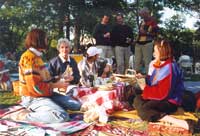
A picnic at Ravinia
photo courtesy Ravinia Festival |
ZARIN MEHTA: That’s the introduction we’re talking about. They get introduced to Gershwin, they get introduced to Messiaen, they get introduced to Beethoven, and I think that our research is proving that once they get used to the concept of listening, and letting this great music wash over them, then they’re going to start coming into the Pavilion, because their knees are gonna get creaky like mine and they won’t be able to bend down…
FRANK J. OTERI: [laughs]
ZARIN MEHTA: …So they’ll want to sit more comfortably.
3. Life Before Ravinia
FRANK J. OTERI: Before we go a little bit further into details about Ravinia, I’d like to find out a little bit more about you and what brought you to Ravinia, and how long you’ve been at Ravinia, and where you were before.
ZARIN MEHTA: Well, very briefly, my background is I’m an accountant, professionally. I was a partner in Coopers and Lybrand in Montreal and was on the board of the Montreal Symphony. After about 10 years on the board, we’d been looking for a managing director. My colleagues on the board talked me into taking a leave of absence to manage the Montreal Symphony, which I did in 1981, and sort of got bitten by the bug. It’s like entering on the lawn, you know, you sort of taste it and you say hey, it’s not so bad. Making money isn’t the end of the world, and I was very satisfied with what I was doing. It also happened to be a very great period for the Montreal Symphony because I’d been instrumental in bringing Charles Dutoit to the music directorship of the orchestra.
FRANK J. OTERI: That was the beginning of the CD revolution. He was really the first conductor to…
ZARIN MEHTA: That’s right. He was one of the first people who knew about it. He found this extraordinary church to record in. We worked very hard to find the right repertoire that didn’t conflict with other orchestras and conductors, and suddenly the orchestra took off. We planned tours, we did all kinds of things, and we had great success. One of the places we came to on tour was Ravinia, in 1988, and we opened the Festival here, played three concerts on the weekend, and had great success. I liked the place, I met the people, et cetera, and Ed Gordon, who’d been the managing director, or the executive director of the festival since 1968 or ’70 or something like that, decided to retire a year later, in ’89. And I ran into him again, we were on tour with the Montreal Symphony, we were in New York, he was in the same hotel as I was, we ran into each other in the elevator. That’s how things happen, right?
FRANK J. OTERI: Wow.
ZARIN MEHTA: And he said, “why don’t you think of coming here?” And I said, “No, I’m so happy with Montreal,” et cetera, “my family’s there,” et cetera. We ended up on a tour in Japan and after four weeks of touring, I decided, you know, maybe I should do something else. Anyway, I said, fine, I might be interested, we talked, and I met Jimmy Levine, who’s the music director, I said, what do you think, and you know, and we decided it was a good idea.
FRANK J. OTERI: Going back earlier, before that, growing up, were you a musician? Did you play an instrument?
ZARIN MEHTA: No, I don’t play an instrument. I am not a musician. I grew up in an extraordinary musical atmosphere in India where my father was “Mr. Western Classical Music” of the country. I think the real key question is how did he become a classical musician?
FRANK J. OTERI: That is a good question.
ZARIN MEHTA: He was born in 1908 and he started studying the violin. I mean, there were no records as such, there was no radio in the ’20’s, really, radio just started, I don’t know what happened in India. Yet he became totally imbued with the idea of classical music. And when we came around, my brother and I, in the ’30’s, ’40’s I guess, we were born in ’36 and ’38, we were surrounded by this Messianic man who only knew about music. He had no other interest in life. I don’t mean that he was narrow-minded: he was interested in art and you know, he came to cricket games with us and so on, but I mean the music was such an important element in his life that… his studio was in our living room, so we were in and out listening to chamber music being practiced, his solo music being rehearsed, he founded the Bombay Symphony, and he would take sectional rehearsals in our living room, so for instance I grew up maybe listening to the 2nd violin section playing the Beethoven 7th Symphony.
FRANK J. OTERI: And not knowing the rest of the piece. [laughs]
ZARIN MEHTA: Well, you know, it’s one of those things. You know, and we used to sit around and set up the music for everyone when we were 6, 7 years old. That sort of thing.
FRANK J. OTERI: Now, in addition to background in western classical music, were you exposed to a lot of Indian classical music?
ZARIN MEHTA: Not that much. Not that much. Actually, my exposure to Indian classical music came about more when I went to London as a student. I don’t know why. I mean, we went to a few concerts. There weren’t that many in those days in Bombay. Certainly Indian dance we experienced quite a lot, I mean, there were some people that, you know, were friends of my family and there were, you know, well-known dancers, and we would go to their concerts. But we never really were exposed and talked about it enough to know enough, any more than maybe you would.
4. Crossover and New Audiences
FRANK J. OTERI: I know, interestingly enough, for me, one of the highlights of your brother‘s tenure with the New York Philharmonic was the commissioning of the 2nd sitar concerto of Ravi Shankar, which is one of the most remarkable syntheses of western music and Indian music, probably even more effective than his first concerto with André Previn.
ZARIN MEHTA: Yeah. And then another sitarist who’s written a sitar concerto and he wants us to do it, and I don’t know, it’s one of those things that we’ll have to look at. I personally feel so strongly about not mixing the mediums. You know, I don’t want to hear Ravi Shankar playing Bach, if you like. I’m not saying that he does, but what is the purpose of it? I agree that the 2nd concerto works better, but when you come right down to it, I’d rather hear him playing an hour of ragas than having an orchestra back him up. To me it doesn’t mean anything.
FRANK J. OTERI: I suppose it’s this question of getting people to come into the Pavilion, though, once again. How do you introduce a western classical audience who’s used to…
ZARIN MEHTA: To Indian music?
FRANK J. OTERI: …the symphony, to symphonic tradition?
ZARIN MEHTA: Well, I don’t think you do it by mixing the genres. I think that’s one of the mistakes people make in our business, is thinking that if you put a jazz artist with an orchestra, that it’ll bring the jazz world and vice versa. I think it keeps both away. I think, if you’re going to do… you know, Oscar Peterson‘s a prime example. Oscar’s from Montreal. I don’t know if you knew that. And in 1984 or so, we did a concert in the Montreal Forum where the ice hockey takes place, which we did a couple of times a year, major public things. We didn’t have an outdoor Ravinia. We used to go into the Forum which is air-conditioned in summer. And we did a jazz concert with the Symphony, Dutoit, it was for the celebration, it was the 5th Anniversary of the Montreal Jazz Festival, we got together to do this concert. The first half was Jean-Luc Ponty, the second half was Oscar. And Oscar had written a piece of 20 or 25 minutes called “Canadiana.” And he really wanted to play it with the Symphony; it was his hometown orchestra. So we said fine. And he did it, and it, you know, it was fine, it wasn’t great. Of course, the public applauded like mad, and I had arranged with him that he’d better play a couple of encores. Well, I tell you, he played a 40-minute encore, which was a medley of Fats Waller and so on. The orchestra sat absolutely spellbound on the stage, the 15,000 people in the arena sat down. And we really had 2 hours of, oh, and hour and a half of jazz crossed with classical music. What really made sense was him playing alone. Totally a cappella, if you like.
FRANK J. OTERI: Right. But perhaps that audience would not have heard that had they not had… it’s the same idea that you were saying before of getting the people to hear Itzhak Perlman to play Tchaikovsky, and then they stay and hear Messiaen’s Turangalîla.
ZARIN MEHTA: But that’s still classical music. That’s not forcing something that doesn’t work. And if you ask the people who were there, they didn’t really enjoy Jean-Luc Ponty although Jean-Luc Ponty, was, you know, as a Frenchman in French Canada, was like a god and sold out everything. Hearing him play with his trio was more interesting than him playing with the orchestra. With the orchestra it didn’t mean much. It was an orchestrated trio.
FRANK J. OTERI: Now, getting to this question, because we’re very interested in figuring out ways to build new audiences for classical music, for music in general, and for American composers, and now that we’re in the last year of the 20th century and approaching the 21st century, how do we bring younger people to hear this music? And how do we get orchestras and festivals and organizations to program more music of our time, and bring in these diverse elements? It’s very hard to say what the genres are anymore.
ZARIN MEHTA: Unfortunately, I think we talk at cross-purposes, in a way. If we talk about bringing in younger people into the hall, and at the same time talk about music of today, classical music of today, it’s unfortunate but I think that’s the reality. One can go back in history and say, hey, at the time of Schubert and Brahms and even Mahler, we played the music of that day. Well, with the revolution in communications, with radio and records and then television, people have gotten used to going back and having this historical document, and we got used to seeing that, and hearing it. So today’s music, in a classical sense, doesn’t have the same caché as does Beethoven or Brahms or Strauss.
FRANK J. OTERI: With a particular audience.
ZARIN MEHTA: I would say for, when you say a particular audience, I would say that’s 90% of the audience.
FRANK J. OTERI: The audience for classical music.
ZARIN MEHTA: Yes.
FRANK J. OTERI: But how do you account for a phenomenon like, say someone like Philip Glass, whose ensemble sells out halls all around America and Europe and brings in people who don’t normally listen to classical music.
ZARIN MEHTA: Yes, but thank you. If Philip Glass was to play in the 2,500-seat hall, 4 times a week for 35 weeks, would he sell out? That’s the question. Okay. I have no problem saying, Philip Glass, come with your ensemble to this 1,000-seat hall, and it will sell out, and if he comes back in two months time, he may sell out. When he comes back next year he’ll sell out again. That’s why I say that it’s a small audience. I’m not saying it doesn’t have to be developed. But will those people, because of being to Philip Glass, come the next week to a concert that includes Messiaen and Beethoven? I don’t know that. I’m not sure that they would. So, also you have to remember that at the turn of the century when we are saying that people went to new music of that time, how many concerts took place? What was happening with the managers and the conductors, you know, in those days the conductors essentially ran the orchestras and the whole thing, right? What was their objective? How many times did they have to fill the hall? Maybe you should go and do research and say, okay, the New York Philharmonic started, what, 150 years ago or something. In the year 1900, how many concerts a week did they play and how many weeks did they play?
FRANK J. OTERI: Well, one of the things I find so impressive now with the New York Philharmonic. . . I was at a concert last week where they did the premiere of the Tan Dun Concerto for Water Percussion. It was really amazing.
ZARIN MEHTA: Yeah, and I think it’s great to do that.
FRANK J. OTERI: And the audience went wild! They were ecstatic. A standing ovation. And this was not easy listening. This was out there, difficult music, really strange sounds, but there was a visual component, people saw these weird objects being immersed in water and making ‘boi-oi-oi-ing’ sounds, and perhaps if you listened to it on the radio or on a recording, it wouldn’t be immediate the way it was in the concert hall. And it was this sort of theatrical ritual, and people loved it. But what I thought was so exciting is I was at the premiere performance which was on a Thursday night. But they did that same program…which, the first half was American repertoire, they did a William Grant Still piece for trombone…
ZARIN MEHTA: How old was that?
FRANK J. OTERI: Maybe from the 1950’s. It was a 10-minute work. It was, in short, very well played. And then the second half was all Richard Strauss…They did this program Thursday night, they did it again Friday afternoon, they did it again Saturday afternoon for the young people’s concert to bring children in to hear this, the Tan Dun Water piece was an amazing to bring kids in with because it’s so visual, then they did the program again Saturday night and Tuesday night. They don’t do the program just once so I thought, wow, they don’t only have to fill up this hall one time with this program, they have to fill up this hall 5 times. But I’m so glad they did it that way because so many people wouldn’t have gotten a chance to hear it otherwise.
ZARIN MEHTA: Yeah. The point I’m making is that if you did a program of music of the last 25 years, 4 times in a week, but you did that for 30 weeks, okay, and only throw in the odd Beethoven or Brahms like you throw in contemporary music now, I don’t think you’d sell tickets. That’s my point.
FRANK J. OTERI: Well, I wonder? I wonder who the younger audiences now, how are we going to get younger people interested in Beethoven and Brahms.
ZARIN MEHTA: Okay, let’s go into that, because this is one of the things that obviously we all have been talking about for a while. The younger people today are no different from the younger people of 25 or 30 years ago. At Ravinia, for example, we have a long-range planning committee like most organizations, and in ’91 or ’92, the committee, obviously there’s management, we guide the committee as to what we as professionals think, and then we use their resources to, you know, affirm and raise money and et cetera. And anyway, the first was renovation facilities, et cetera, the second was what should we do for the community and the third is audience development. So we’re talking about audience development now. And one old-time trustee who’s in his late eighties, about three years ago sent me a file that he had in his office, I guess, or home, and was his long-range plan chairmanship from 1962. And I have it – I gave it to Jean [Oelrich] and Jack [Zimmerman]. Guess what they are talking about? The audience is graying, how do we get the young people in? [laughs]
5. The Expansion of the Orchestra Season
FRANK J. OTERI: There certainly is a smaller audience now, though, than there was in the past for standard repertoire concerts.
ZARIN MEHTA: Yeah, but that also… The difference in 1962 was, the audience, I think, for classical music has always been more than a little gray. What was happily heart-warming in those days, was there was a young generation like yourself coming up to take their place. And what started to concern me in the ’80’s and the ’90’s now is that that young generation is not coming up in the same numbers. Okay? Secondly, the numbers have changed. The numbers we need have changed, in other words. In 1960 or ’62, how many orchestras had year-round employment? Have we thought about that?
FRANK J. OTERI: There are actually more orchestras now.
ZARIN MEHTA: Not only more orchestras, but those orchestras that even existed as major orchestras in 1962 have year-round employment; therefore, they’re playing more concerts. The Chicago Symphony used to play twice a week. They now play 4 times a week downtown.
FRANK J. OTERI: That’s wonderful. And selling out.
ZARIN MEHTA: Yeah, great. We’re selling out, because the audience is growing in the ’70’s and the ’80’s. But as the Chicago Symphony succeeds in the city with making money and with culture and everything else, and with the ability of being an extraordinary orchestra, they’re able to attract the Barenboims and the Abbados and the Soltis to conduct, at the same time, the orchestras in the rest of the country say, hey, our musicians need full-time employment, too. So what happened? Minneapolis went to 52 weeks, and St. Louis went to 52 weeks and Dallas went to 52 weeks. But they didn’t attract the big names for obvious reasons. They weren’t as big cities as Chicago. And their audiences started to come down. That’s where the problems arise, is that you don’t have the public to fill that. We need to suddenly double the number of seats available for classical music. It’s not that we’ve gone down. Maybe we’re selling more than we did in 1962 or 1968. We’re offering a lot more product.
FRANK J. OTERI: Right. So maybe the choice is to have a shorter season.
ZARIN MEHTA: But you can’t because then what do you do with your musicians? I think the musicians deserve full-time employment. You get paid 52 weeks of the year, I hope.
FRANK J. OTERI: Right. [laughs]
ZARIN MEHTA: I do. Why should a wonderful musician who’s playing in the orchestra get paid for 40 weeks? I mean, when you think about it, that’s how Ravinia started. I don’t know if you know that. In 1935, Frederick Stock went to a group of his supporters and said, “The Chicago Symphony musicians are only paid for 28 weeks” or something like that. Imagine that. When you listen to the recordings from that time, they were pretty damn good, right? You only get paid for 28 weeks.
FRANK J. OTERI: Wow. What were they doing the rest of the year, one wonders?
ZARIN MEHTA: Teaching, playing in the movie pits, God knows, okay? Maybe working as plumbers, for all you know. So what happened was they started Ravinia as a result of that. We didn’t engage the Chicago Symphony. We engaged the individual musicians for 8 weeks and called them the Chicago Symphony, because we engaged those musicians. The Chicago Symphony Association had nothing to do with Ravinia. That’s why it’s been a completely separate organization.
FRANK J. OTERI: Interesting.
ZARIN MEHTA: We didn’t start engaging them directly with the Association until about 1968 or 1970, I think.
FRANK J. OTERI: Wow. But you were billing it as the Chicago Symphony Orchestra.
ZARIN MEHTA: Yeah, I mean, you know, with approval and so on. So what happened? What did the change? I think the change that took place was very simply that as the world became smaller, we go back to the idea of the global village because of the communication situation, this is absolutely true, we got into the lack of culture. First of all, we got influenced more and more by the media. The media was not the newspapers anymore, it wasn’t the radio anymore, it was first television, and now…
FRANK J. OTERI: The Internet.
6. The Internet
ZARIN MEHTA: The Internet. [laughs] Okay.
FRANK J. OTERI: I really think it’s a chance to get this music back into the mainstream.
ZARIN MEHTA: Yeah, but just as much as you might be doing on your Web page, there’s rap pages and pop pages, and every, you know, Chris Isaak and so on have their own web pages and this is what people are hitting on.
FRANK J. OTERI: Well, maybe there’s a way to bring it all together. To get the people who listen to rap and Chris Isaak and…
ZARIN MEHTA: Maybe. I think we have to do all that. Absolutely.
FRANK J. OTERI: Now, Ravinia has a Web presence.
ZARIN MEHTA: Very much so. In fact, you’d be interested in the statistics. I think you saw what happened last year. We were very pleased because I think we sold about $350,000 worth of tickets on the Web last year, in the whole season. Two nights ago we hit $500,000 this year. And the season hasn’t started.
FRANK J. OTERI: Wow. Already? All on the Web?
ZARIN MEHTA: Yeah. What is also very exciting to us is 77% — I’m saying this because it’s so fresh now, that we were looking at this – 77% of the names of the people who bought tickets are new names.
FRANK J. OTERI: That is tremendous. That’s absolutely tremendous. And that speaks very well for the future…
ZARIN MEHTA: What you’re analyzing now, I wish I could tell you, is I don’t know how many of them are classical buyers. I would think most of the Web buyers are for pop concerts, because they’re going to be younger people who use the Web. That’s tremendous, even if 20% of that is classical, I would be thrilled.
FRANK J. OTERI: That’s still fantastic.
ZARIN MEHTA: Because it’s a new audience that’s coming to classical music. And this is all Pavilion tickets, this is not lawn.
FRANK J. OTERI: Not picnic? Wow. Now I’d be curious, are they mostly people in the Chicago area or are they people from all over the country?
ZARIN MEHTA: Not only Chicago area but 56 or 57% are from the north and northwest suburbs.
FRANK J. OTERI: That’s wonderful.
ZARIN MEHTA: So those are the people that, you know, in effect, populate Ravinia.
FRANK J. OTERI: The wonderful thing about the Web is that you can reach anybody anywhere in the world, and they can find out about you. There was an interesting session that began the American Symphony Orchestra League Conference which I’ve been at all week, and people talking about the Web and saying, well, gee, we should, orchestras, we probably should be fearing this Web thing because now people can hear other orchestras on the Web and they’re not going to come to our concert halls and this is not true because nothing replaces a live experience.
ZARIN MEHTA: People said when records came out then CDs that they’d stay home and listen to CDs and people wouldn’t come to concerts. But, in fact, in 1980 when the CD came out, it increased the audience for classical music, because it encouraged people to go out and hear things live. Very few people want just to sit home and do nothing. They want to go out.
FRANK J. OTERI: And what a lot of people have said to me is if they listen to a recording or if they hear something on the radio, they’re distracted. They get a telephone call. They have to deal with family or with someone coming over, whereas if you’re at a concert hall, it’s a sanctuary. There are no cell phones.
ZARIN MEHTA: That’s what I said about sitting on the lawn at Ravinia.
FRANK J. OTERI: Yeah.
ZARIN MEHTA: Of course, you hang amplified… an amplified concert, but you are sitting with 10,000 other people doing the same thing.
FRANK J. OTERI: And there are no other distractions. There’s nothing else calling for your attention.
ZARIN MEHTA: That’s what’s so extraordinary about it. So you see on the Web what we are doing also, is not only from a sales standpoint are we putting that we have, you know, the Chicago Symphony with Eschenbach doing x, but we will do a little biography of the artist, we’ll do a little accompanying program note. That’s also educating the person. Sound bytes are going to be the next thing that we’ll have to start inserting.
FRANK J. OTERI: Oh, wonderful! That would be wonderful.
ZARIN MEHTA: So people can hear, you know, thirty seconds of, I don’t know, La Valse or whatever.
7. Developing Younger Performers and New Repertoire
FRANK J. OTERI: Let’s talk about education for a minute, because Ravinia has a wonderful program, the Steans Institute, which has been part of the vision of Ravinia, and this is a way of bringing in younger audiences and training the next generation of musicians.
ZARIN MEHTA: The Steans Institute started 10 years ago as a means of, if you like, a finishing school for extraordinarily talented young instrumentalists and singers. Two separate sessions. Right now, we just, I think, Isaac Stern just finished three weeks of his, I’m not sure what he called it, master classes at Carnegie Hall. Almost every group that performed with him, or studied with him in his group of people, there were people who had been at the Steans Institute. Every single one of them. This was very exciting to us. And the talent that’s out there, the number of extraordinarily talented young people who are coming out of our conservatoires and so on, if one wanted to be pessimists and say isn’t it great but where are they going to play and who are they going to play for? But I think that the more people that are involved in classical music the more proselytization there is outside and the more people will come to hear these young… our rising stars concerts is proving that. When you put a young person like Vadim Repin to play a concerto with the symphony, he’s selling as much as a Peter Serkin now. And that’s not to downplay Peter Serkin. I’m just saying people are excited by seeing youth out there to perform.
FRANK J. OTERI: This is wonderful. Let’s bring it back to composition a bit. We’re talking about new and seeing new performers and how exciting that is. What can we do to develop repertoire, to get new composers, to get people hearing new things?
ZARIN MEHTA: Well, I don’t know if you’re aware of a thing I started about 4 years ago called Music Accord. We haven’t really made a big thing out of it by making a press release or anything, but it is a cartel of eight presenters across the country, and we came together in New York, 3 years ago, 4 years ago, with the view of commissioning music from American composers, the idea being that when music is commissioned today, it’s commissioned by an orchestra, by an individual, and he’ll play it, the orchestra will play it once, maybe, another time four years later, et cetera. If more than one person commissions, then you’re hearing it all over the country. So as a result, the idea was to replenish the repertoire. We at the Festival could not really do that with orchestral music because of the lack of rehearsal time we have in the summer, so we said we should do this for instrumental and chamber music and we came up with the following thing. Each year we would commission three pieces: one vocal cycle, one instrumental and one for a chamber group. And I was very careful to say for the chamber group it had to be for an established kind of group, I don’t mean a name, but it had to be a trio or quartet that is a normal format. Because today, with contemporary composers, they let their things go like Mr. Tan Dun, and he writes something for, you know, a water buffalo and a saxophone…
FRANK J. OTERI: [laughs]
ZARIN MEHTA: And that may be very interesting but then it doesn’t get repeated. I mean, this piece that you’re talking of with the New York Philharmonic: how many people are going to redo it? What’s it going to take to redo it?
FRANK J. OTERI: It is going to be a challenge.
ZARIN MEHTA: Right. I’ve been through that. So I said let’s do it for an existing group. So the next step was to sort of find the artists that all eight wanted to present or could present based on their economics, et cetera, and to make a long story short, the first year we had this cello piece of Tobias Picker for Lynn Harrell, and Lynn was going to premiere it at Ravinia last year, but he was not well, he had an operation, so he did it at Lincoln Center 2 months ago, he’s doing it next month here, he’s going to do it in San Francisco, et cetera. Frederica von Stade did a song cycle of Jake Heggie. And the Borromeo Quartet is going to do a quartet of Steve Mackey. That’s the first one. Then we have commissions coming out for Manny Ax, Florence Quivar…
FRANK J. OTERI: Who’s writing the piece for Manny Ax?
ZARIN MEHTA: …Nicholas Maw, I think. Sorry, we kept changing.
FRANK J. OTERI: So it’s not just American composers.
ZARIN MEHTA: Well, I wanted it to be mainly, but Manny really wanted to do it and he had been talking so I said, sure, go ahead, you know, it’s new music after all. But it’s going to be 90% American composers. Not for any reason other than saying, people ask me why are we being so chauvinistic, if you like, and I say far be it for me to be chauvinistic. [laughs] But the European composers have a greater access to money from the governments and so on, whereas the American composers don’t and especially young ones, and it depends on the largesse of either orchestras or societies or individual musicians. So that’s how we’re doing it.
FRANK J. OTERI: Now I notice, you mentioned the difficulties of premiering a new orchestral work at a venue like Ravinia. But I did notice this summer there that you are going to be presenting music of Christopher Rouse, who’s one of our…
ZARIN MEHTA: Yeah, but that’s a piece that Christoph [Eschenbach] has done. He knows it, he knows how much rehearsal time it takes, it’s not a premiere.
FRANK J. OTERI: Because what better way to introduce new audiences to a new piece than to hear it outdoors in a comfort zone like Ravinia, as opposed to a concert hall.
ZARIN MEHTA: Yeah. If we knew what rehearsal time would be required it would make it that much easier. When you commission a new work, you don’t know. You know, recently the NHK Symphony Orchestra came to Chicago and when we booked them, they had commissioned a piece by Sofia Gubaidulina. They asked for a 10-minute piece to open the program. The rest of the program was Sarah Chang playing, I forget, Sibelius, and then the Prokofiev 5. It turned out that this Gubaidulina piece ended up at 30 minutes.
FRANK J. OTERI: Wow. [laughs]
ZARIN MEHTA: It was difficult. So what do you do with the rest of the program? This is like three weeks before the tour. It was, we had a long program, and the piece went on for 30 minutes.
FRANK J. OTERI: What was the audience reaction?
ZARIN MEHTA: Good. That was fine, but they had, you know, because it was a tour and because they had time before the tour to rehearse it everything’s fine, but if that suddenly happened to Ravinia we wouldn’t know how to rehearse it. It would cost me thousands of dollars for overtime to do it.
FRANK J. OTERI: How many rehearsals per concert, on average?
ZARIN MEHTA: Two.
FRANK J. OTERI: So that Messiaen Turangalîla Symphony was only rehearsed twice?
ZARIN MEHTA: No, in that case we did three. We did overtime, we planned the rest of the program in that week in a way that we could do it with less rehearsal. Itzhak [Perlman] playing Tchaikovsky was, you know, fairly straightforward with the Chicago Symphony, you could imagine, we did a run through, et cetera.
8. Spare Time
FRANK J. OTERI: With all the stuff that you’re doing, and I know you have a very busy schedule, what do you do in your spare time? What music do you listen to? Do you have time to do that?
ZARIN MEHTA: Well, it’s not a question of having time. I have to make the time because I have to listen to so many things, tapes and records of young individuals from our Rising Stars concerts, other things that, you know, I get. I just bought the complete recordings of Martha Argerich. You know, I want to listen to that.
FRANK J. OTERI: Right.
ZARIN MEHTA: I don’t listen to pop.
FRANK J. OTERI: Do you listen to jazz?
ZARIN MEHTA: I listen to less jazz than I used to because of the time. So my listening now is coming more on the basis of things I need to listen to, for purposes of either auditioning the individual, or some, a piece that I wanted to program and I want to rehear it to see how it is, you know, that sort of thing.
FRANK J. OTERI: Any new music that you’ve listened to in the past year that…?
ZARIN MEHTA: A man called Dashow sent me a couple of records of electronic music and I don’t know quite where to put it.
FRANK J. OTERI: James Dashow?
ZARIN MEHTA: You know, that sort of thing. But it’s kind of fun to listen to those things. But you know, new music, it’s not really new music so much as often, I will listen to something of Messiaen …Trois Petite Liturgies for instance, okay? We’ve performed it in Montreal, I’ve heard it, but you know, it’s not something that I know as I would know a, say, Beethoven or Brahms Symphony. So I would listen to it again to see how it would work in the atmosphere that I’m talking about. So I would listen to things on that basis.
FRANK J. OTERI: Any chance of James Dashow’s electronic music or the Messiaen turning up at Ravinia in the next couple of years?
ZARIN MEHTA: I don’t know. That’s why I say I have to find the right way of doing it. The right programmatic mix and so on. And the people to do it.
FRANK J. OTERI: Right. Well, it was a tremendous pleasure to meet with you here at this hotel, and thank you for your time, and I hope to get to Ravinia again soon.
ZARIN MEHTA: A pleasure. You’re welcome any time.
Zarin Mehta was born in Bombay in 1938, the son of violinist and conductor Mehli Mehta. Since 1990 Zarin Mehta has held the positions of executive director and chief operating officer of the Ravinia Festival, which offers more than 130 music and dance performances each June through September. Every summer since 1936, the Festival has featured the Chicago Symphony Orchestra performing more than 22 separate symphonic programs.
Under Mehta’s leadership, Ravinia Festival has attracted new audiences and has inaugurated several new programs, including the innovative “Rising Stars” series of indoor recitals and chamber music performances. Currently in its ninth year, Rising Stars at Ravinia introduces to Chicago audiences talented young musicians certain to make their mark upon the cultural landscape of the 21st century. Avant-garde and world music is explored every summer in Mehta’s adventurous Musica Viva series, which offers Ravinia audiences numerous national and international premieres. Mehta has also expanded the Festival’s series of Saturday morning children’s concerts.
Consolidating and giving focus to the Festival’s jazz programming, Mehta created Jazz at Ravinia, a concentrated annual series of jazz performances featuring many of the biggest names of the international jazz scene.
During his Ravinia tenure, Mehta has spearheaded numerous community outreach initiatives, including the Jazz in the Schools Mentor Program through which Ravinia places eight professional jazz musicians in Chicago Public High Schools to share with students their knowledge and expertise during 400 school visits. In 1994, under Mehta’s guidance, the Festival appointed one of the world’s most sought-after conductors, Christoph Eschenbach, to the post of music director.
Mehta, whose father was conductor of the Bombay Symphony Orchestra, left India as a teenager to study accounting in England. In 1962 after qualifying as a Charted Accountant, he moved to Canada to join the international accounting firm of Coopers & Lybrand. While a partner with that prestigious firm, he joined the Montreal Symphony Orchestra Board of Directors and later became its vice president.
In 1981 Coopers & Lybrand granted him an indefinite leave of absence to devote his energy to the position of managing director of the Montreal Symphony Orchestra. During his tenure the orchestra’s subscription base as well as its fundraising and operating revenues markedly increased, as did its reputation as one of the world’s great symphonic ensembles. For his contributions to the orchestra and Montreal’s cultural life, the Canadian government named Mehta a Member of the Order of Canada.
Through the years Mehta has garnered numerous other honors. Among the most recent are Dominican University’s 1996 Bravo Award for his distinguished contributions to the fine arts; the 1997 Arts Entrepreneurship Award from Chicago’s Columbia College; and the 1998 Dushkin Award from the Music Institute of Chicago (formerly Music Center of the North Shore). In May 1998 Mehta received an honorary doctorate from Chicago’s Roosevelt University.
Zarin Mehta is married to Carmen Lasky, with whom he has two children, daughter Rohanna, born in 1967, and son Rustom, born in 1968.


